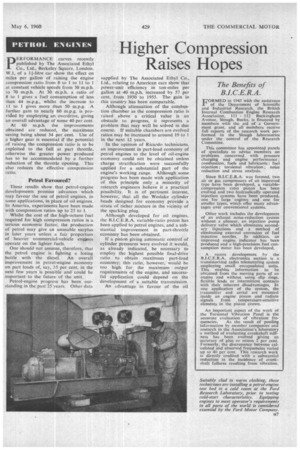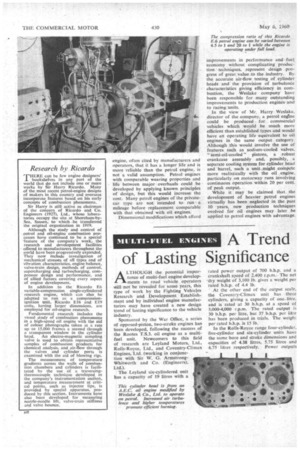Higher Compression Raises Hopes
Page 121

Page 122

If you've noticed an error in this article please click here to report it so we can fix it.
supplied by The Associated Ethyl Co., Ltd., relating to American cars show that power-unit efficiency in ton-miles per gallon at 40 m.p.h. increased by 57 per cent. from 1930 to 1955. The gain in this country has been comparable.
Although attenuation of the cotnbustion chamber as the compression ratio is raised above a critical value is an obstacle to progress, it represents a problem that may well be solved in due course. If suitable chambers are evolved ratios may be increased to around 19 to 1 in the next 12 years.
In the opinion of Ricardo technicians, an improvement in part-load economy of petrol engines to the level of oil-engine economy could not be obtained unless charge stratification were successfully applied for a substantial part of the engine's working range. Although some progress has been made with application of this principle only a minority of research engineers believe it a practical possibility. It is of pertinent interest, however, that all the Weslake cylinder heads designed for economy provide a strata of richer mixture in the vicinity of the sparking plug.
Although developed for oil engines, the B.I.C.E.R.A. variable-ratio piston has been applied to petrol engines, and a substantial improvement in part-throttle economy has been obtained.
If a piston giving automatic control of cylinder pressures were evolved it would, as already indicated, be necessary to employ the highest possible final-drive ratio to obtain maximum part-load economy; this ratio, however, would be too high for the maximum output requirements of the engine, and successful application could depend on the development of a suitable transmission.
An advantage in favour of the oil
engine, often cited by manufacturers ami operators, that it has a longer life and is more reliable than the petrol engine, is not• a. valid assumption. Petrol engines with comparable wearing properties and life between major overhauls could be developed by applying known principles of design, but this would increase the cost. Many petrdl engines of the privatecar type are not intended to run a mileage before replacement comparable with that obtained with oil engines.
Dimensional modifications which afford improvements in performance and fuel economy without complicating production techniques, represent design progress of great value to the industry. By the accurate air-flow testing of cylinder heads and the provision of turbulence characteristics giving efficiency in combustion, the Weslake company have been responsible for many outstanding improvements to production engines-and to racing units.
In the view of Mr. Harry Weslake. director of the company, a petrol engine could he produced for commercial vehicles which would be much more efficient than established types and would have an operating life equivalent to oil engines in the same output category. Although this would involve the use of features such as sodium-cooled valves, " semi-oil-cooled " Pistons, a robust crankcase assembly and, possibly, a separate cooling system for cylinder head and barrel, such a unit might compete more realistically with the oil engine. particularly on motorway runs involving continuous operation within 20 per cent. of peak output.
While it may be claimed that the development of heavier petrol engines virtually has been neglected in the past 10 years, new production techniques evolved for oil engines may later be applied to petrol engines with advantage.




































































































































































































































































